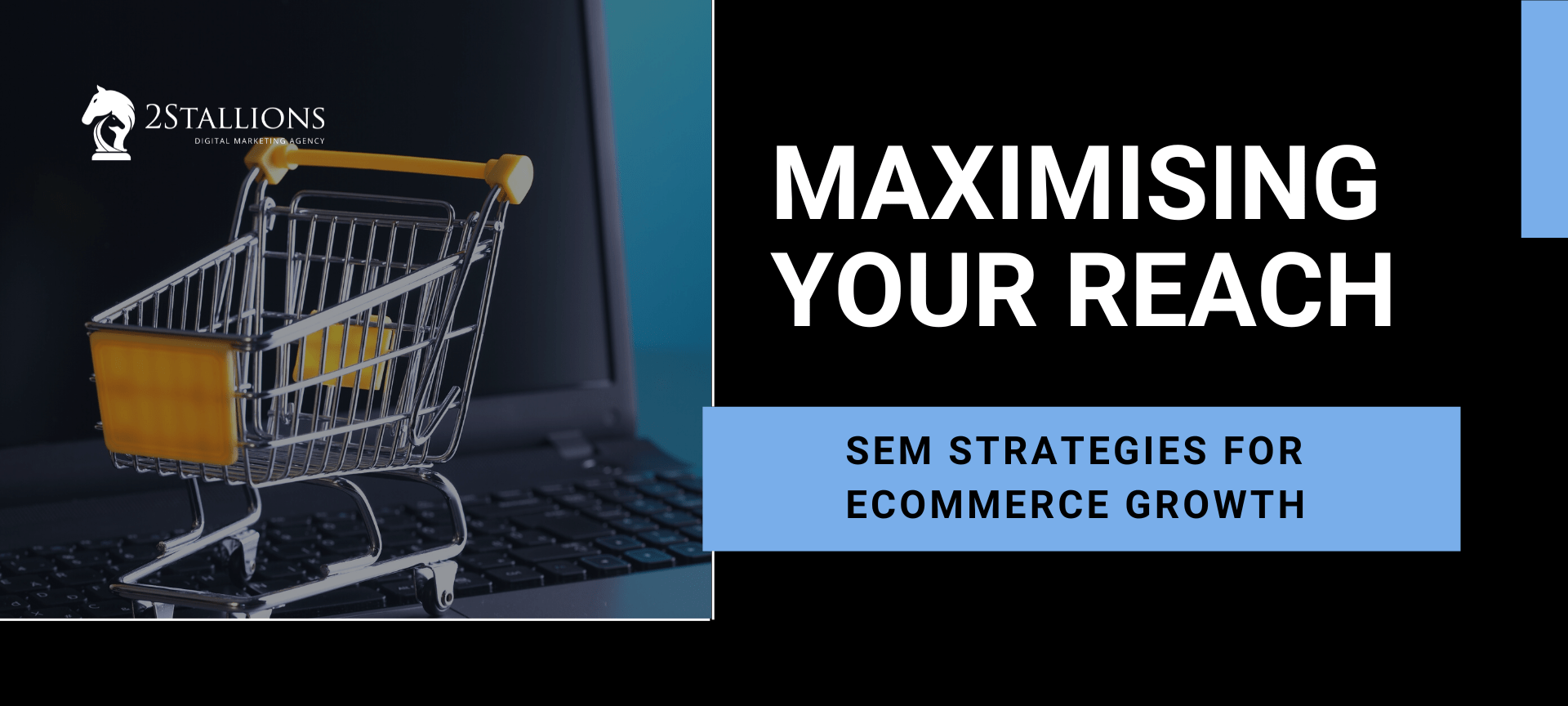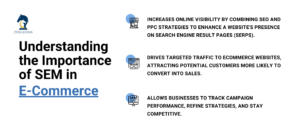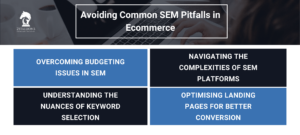SHARE

SEM, or Search Engine Marketing, plays a crucial role in the growth of ecommerce businesses. SEM strategies can improve online retailer visibility in search engine results, attract more website traffic, and increase sales. This article will explore the importance of SEM in ecommerce, key SEM strategies for success, how to measure SEM performance, common pitfalls to avoid, and future trends to watch out for.
Understanding the Importance of SEM in Ecommerce
In today’s digital age, where consumers increasingly rely on search engines to find products and services, SEM has become vital for online business growth. SEM encompasses various techniques, including search engine optimisation (SEO) and pay-per-click (PPC) advertising, to increase a website’s visibility on search engine result pages (SERPs).
Furthermore, SEM is not just about increasing visibility but also about driving targeted traffic to websites. By targeting specific keywords and demographics, ecommerce businesses can attract potential customers more likely to convert, leading to increased sales and revenue.
The Role of SEM in Online Business Growth
SEM plays a pivotal role in the growth of ecommerce businesses by driving targeted traffic to their websites. When a potential customer searches for a specific product or service related to an online retailer’s offerings, effective SEM ensures that the retailer’s website appears prominently in the search results, increasing the likelihood of attracting qualified visitors.
Moreover, SEM allows businesses to track and measure the performance of their campaigns effectively. By analysing data such as click-through rates, conversion rates, and return on investment, ecommerce retailers can refine their SEM strategies to maximise results and achieve their business objectives.
How SEM Impacts Your Ecommerce Visibility
With countless websites competing for users’ attention, visibility is key to ecommerce success. Implementing SEM strategies, such as optimising website content for relevant keywords and running targeted PPC campaigns can enhance retailers’ visibility on SERPs. This increased visibility helps them stand out among competitors and reach potential customers actively searching for products or services they offer.
Furthermore, SEM allows ecommerce businesses to stay ahead of industry trends and consumer behaviour. By staying updated on popular search terms, emerging technologies, and changes in search engine algorithms, online retailers can adapt their SEM strategies to remain competitive and relevant in the ever-evolving digital landscape.
Key SEM Strategies for Ecommerce
To make the most of SEM, ecommerce businesses should employ several key strategies:
Utilising Keyword Research for Effective SEM
Keyword research is the foundation of successful SEM campaigns. By identifying the keywords and phrases potential customers use to search for products or services, online retailers can optimise their websites and create compelling content that aligns with users’ search intent. This targeted approach ensures that their website appears in the right searches, increasing the likelihood of attracting qualified leads.
The Power of Ad Copy in SEM
Compelling ad copy is essential in attracting users’ attention and driving clicks. Thoughtful ad copy that highlights the unique selling points of a product or service can make a difference in the click-through rate (CTR) of PPC campaigns. Online retailers should craft concise, persuasive ad copy that stands out from the competition and entices users to click on their ads.
Landing Page Optimisation for SEM Success
Once users click on an ad, a well-optimized landing page becomes crucial. A landing page should be designed to provide a seamless user experience, providing the information visitors need and encouraging them to take the desired action, whether purchasing, filling out a form, or signing up for a newsletter. Optimising landing pages can maximise conversion rates and turn visitors into loyal customers.
Moreover, it is important to note that in the ever-evolving world of ecommerce, staying up-to-date with the latest trends and techniques is paramount. For instance, incorporating video content into SEM strategies has become increasingly popular. Videos can engage users and provide a more immersive experience, allowing online retailers to showcase their products in action and connect with potential customers on a deeper level.
Additionally, social media platforms have become a powerful tool for SEM. Integrating social media advertising into SEM campaigns can help businesses reach a wider audience and target specific demographics. By leveraging the vast user base and advanced targeting options on platforms like Facebook and Instagram, ecommerce businesses can effectively promote their products or services to the right people at the right time.
Furthermore, the significance of SEM mobile optimisation is essential. With the rise of smartphones and tablets, ensuring that websites and ads are mobile-friendly is crucial. Mobile users have different browsing habits and expectations, so tailoring the SEM strategy to cater to this audience is essential for success. Optimising landing pages for mobile devices, implementing responsive design, and utilising mobile-specific ad formats are just a few ways ecommerce businesses can enhance their SEM efforts in the mobile era.
Measuring the Success of Your SEM Strategies
Measuring the performance of SEM campaigns is essential to understand their effectiveness and make data-driven decisions for continuous improvement. Key metrics to track include:
Identifying Key SEM Metrics
Metrics such as click-through rate (CTR), conversion rate, cost per acquisition (CPA), and return on ad spend (ROAS) provide insights into the performance of SEM campaigns. By analysing these metrics, ecommerce businesses can identify areas for improvement and optimise their SEM strategies to drive better results.
Interpreting SEM Data for Continuous Improvement
SEM data provides valuable insights into customer behaviour, preferences, and trends. By closely monitoring and analysing the data, online retailers can identify patterns and make informed decisions. They can allocate budgets more effectively, adjust keyword strategies, refine ad copy, and optimise landing pages to improve the performance of their SEM campaigns.
Furthermore, businesses must understand the competitive landscape in which their SEM campaigns operate. Thorough competitor analysis can help companies gain valuable insights into what strategies work for others in the industry. This information can help benchmark performance and set realistic goals for SEM campaigns.
Moreover, staying abreast of the latest trends and updates in search engine algorithms is paramount for the success of SEM strategies. Search engines frequently update their algorithms to provide users with more relevant and high-quality search results. Therefore, businesses need to adapt their SEM tactics to align with these changes to maintain visibility and competitiveness in the online space.
Avoiding Common SEM Pitfalls in Ecommerce
While SEM offers immense benefits, there are some pitfalls that ecommerce businesses should be aware of:
Overcoming Budgeting Issues in SEM
SEM campaigns can quickly consume budgets if not managed carefully. Online retailers must set realistic budgets, allocate funds wisely across different SEM channels, and regularly monitor spending. By balancing their budget and optimising their campaigns based on performance, ecommerce businesses can achieve better ROI and prevent overspending.
Navigating the Complexities of SEM Platforms
SEM platforms often have complex interfaces and require knowledge of various tools and features. Ecommerce businesses must stay updated with the latest developments and best practices in SEM. By doing so, they can leverage the full potential of SEM platforms and effectively manage their campaigns.
Understanding the Nuances of Keyword Selection
One key aspect of successful SEM campaigns is the selection of relevant keywords. Ecommerce businesses must conduct thorough keyword research to identify high-performing keywords that align with their products or services. By targeting the right keywords, companies can improve their ad relevance, reach their target audience more effectively, and drive higher conversion rates.
Optimising Landing Pages for Better Conversion
In addition to running well-structured SEM campaigns, ecommerce businesses need to focus on optimising their landing pages. A well-designed and user-friendly landing page can significantly impact conversion rates. By ensuring that landing pages are relevant to the ad content, easy to navigate, and include clear calls-to-actions, businesses can enhance the overall effectiveness of their SEM efforts and maximise their return on investment.
Future Trends in SEM for Ecommerce
As SEM is constantly developing, ecommerce businesses should stay ahead of the curve to maintain their competitive edge. Two significant future trends to watch out for are:
The Rise of Voice Search in SEM
Voice search technology, powered by virtual assistants like Siri and Alexa, is rapidly becoming mainstream. Ecommerce businesses should optimise their websites and SEM strategies to accommodate voice-based queries. Tailoring content to match natural language patterns and incorporating conversational keywords will be key to success in the voice search era.
The Impact of AI on SEM Strategies
Artificial Intelligence (AI) is revolutionising the way SEM campaigns are managed. AI-powered tools can automate tasks, analyse vast amounts of data, and provide real-time insights. Ecommerce businesses should embrace AI technologies to enhance their SEM strategies, improve targeting, and deliver personalised customer experiences.
In addition to these trends, ecommerce businesses need to consider the role of visual search in SEM. Visual search allows users to upload images or use a camera to search for products, making the shopping experience more interactive and seamless. Optimising product images with descriptive alt text and implementing schema markup can improve visibility in visual search results, providing a competitive advantage in the evolving landscape of SEM.
Furthermore, the integration of social commerce into SEM strategies is gaining momentum. With the increasing popularity of social media platforms as shopping destinations, ecommerce businesses can leverage targeted advertising and shoppable posts to drive traffic and conversions. Building a strong social presence, engaging with customers, and monitoring social metrics are essential to a successful social commerce strategy.
In conclusion, SEM is an indispensable part of ecommerce growth. By understanding the importance of SEM, implementing key strategies such as keyword research, optimising ad copy and landing pages, measuring performance, avoiding common pitfalls, and staying abreast of future trends, online retailers can maximise their reach and achieve sustainable growth in the competitive ecommerce landscape.
SEM & Ecommerce FAQs
What are key SEM strategies for ecommerce growth?
Key SEM strategies include optimising ad campaigns with targeted keywords, utilising shopping ads to showcase products, implementing dynamic remarketing to re-engage visitors, and consistently analysing and refining ad performance.
How can ecommerce businesses effectively use keywords in SEM?
Ecommerce businesses should conduct thorough keyword research to identify terms their target audience uses, focusing on long-tail keywords for better conversion rates, and continuously updating their keyword lists based on performance and market trends.
What role do shopping ads play in SEM for ecommerce?
Shopping ads play a crucial role by visually showcasing products directly in search results, providing consumers with immediate product information like pricing and reviews, which helps increase click-through rates and conversions.
How can ecommerce businesses measure the success of their SEM efforts?
Success in SEM can be measured by tracking metrics such as click-through rate (CTR), conversion rate, cost per acquisition (CPA), and return on ad spend (ROAS), enabling businesses to assess the effectiveness of their campaigns and make data-driven decisions.
















